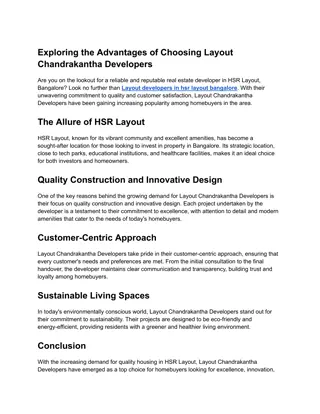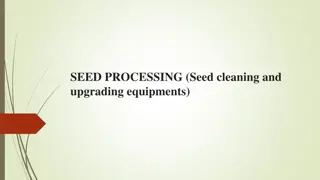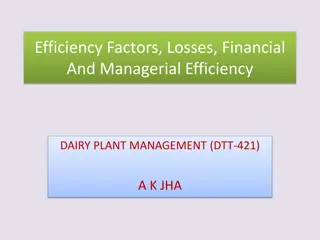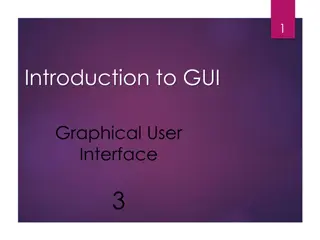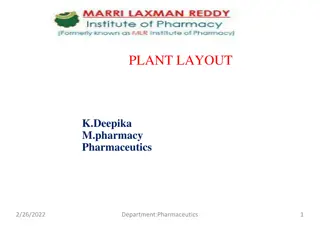Understanding Plant Layout: Optimization for Efficiency
Plant layout and facility layout are crucial for optimizing operations efficiency and cost-effectiveness. Factors like plant location, nature of product, and spatial requirements influence layout decisions. The objective of layout design is to ensure a smooth flow of work, materials, and information through the system, aiming to enhance product quality, utilize resources efficiently, and minimize production time. Different types of plant layouts, such as product-oriented and process-oriented layouts, are employed based on the production process requirements. Effective layout design can lead to improved workflow and reduced operational costs.
Download Presentation

Please find below an Image/Link to download the presentation.
The content on the website is provided AS IS for your information and personal use only. It may not be sold, licensed, or shared on other websites without obtaining consent from the author. Download presentation by click this link. If you encounter any issues during the download, it is possible that the publisher has removed the file from their server.
E N D
Presentation Transcript
Plant Layout Page 1
Facility Layout Layout refers to the configuration of departments, work centers, and equipment, with particular emphasis on movement of work (customers or materials) through the system. Layout decisions are important for three basic reasons: 1. require substantial investments of money and effort; 2. involve long-term commitments, which makes mistakes difficult to overcome; and 3. have a significant impact on the cost and efficiency of operations Page 2
Factors affecting Plant Layout 1. Plant location and building 2. Nature of Product 3. Type of Industry 4. Plant Environment 5. Spatial Requirements 6. Repairs and Maintenance 7. Balance 8. Management Policy 9. Human Needs 10.Types of machinery and equipment Page 3
The basic objective of layout design is to facilitate a smooth flow of work, material, and information through the system. Supporting objectives generally involve the following: To facilitate attainment of product or service quality. To use workers and space efficiently. To avoid bottlenecks. To minimize material handling costs. To eliminate unnecessary movements of workers or materials. To minimize production time or customer service time. To design for safety. Page 4
Plant Layout : Types Page 5
The production process normally determines the type of plant layout to be applied to the facility: Fixed position plant layout Product stays and resources move to it. Product oriented plant layout Machinery and Materials are placed following the product path. Process oriented plant layout (Functional Layout). Machinery is placed according to what they do and materials go to them. Combined Layout Combine aspects of both process and product layouts Page 6
Product oriented plant layout This type of plant layout is useful when the production process is organized in a continuous or repetitive way. Continuous flow : The correct operations flow is reached through the layout design and theequipment and machinery specifications. Repetitive flow (assembly line): The correct operations flow will be based in a line balancing exercise, in order to avoid problems generatedby bottle necks. The plant layout will be based in allocating a machine as close as possible to the next one in line, in the correct sequence to manufacture the product. Page 7
Product Layouts Product layouts are used to achieve a smooth and rapid flow of large volumes of goods or customers through a system. Page 10 8
Advantages A high rate of output Low unit cost due to high volume Labor specialization Low material-handling cost per unit A high utilization of labor and equipment The establishment of routing and scheduling in the initial design of the system Fairly routine accounting, purchasing, and inventory control Disadvantages Morale problems and to repetitive stress injuries. Lack of maintaining equipment or quality of output. Inflexible for output or design Highly susceptible to shutdowns A high utilization of labor and equipment Preventive maintenance, the capacity for quick repairs, and spare-parts inventories are necessary expenses Incentive plans tied to individual output are impractical Page 10 9
Process Layouts Process layouts are designed to process items or provide services that involve a variety of processing requirements. Page 10 10
Process oriented plant layout (Functional Layout) This type of plant layout is useful when the production process is organized in batches. Personnel and equipment to perform the same function are allocated in the same area. The different items have to move from one area to another one, according to the sequence of operations previously established. The variety of products to produce will lead to a diversity of flows through the facility. The variations in the production volumes from one period to the next one (short periods of time) may lead to modifications in the manufactured quantities as well as the types of products to be produced. Page 11
Advantages Handle a variety of processing requirements Not vulnerable to equipment failures General-purpose equipment is less costly and is easier and less costly to maintain Possible to use individual incentive systems Disadvantages In-process inventory costs can be high Routing and scheduling pose continual challenges Equipment utilization rates are low Material handling is slow and inefficient, and more costly per unit Job complexities reduce the span of supervision and result higher supervisory costs Special attention necessary for each product or customer and low volumes result in higher unit costs Accounting, inventory control, and purchasing are much more involved Page 14 12
Fixed-Position Layouts In fixed-position layouts, the item being worked on remains stationary, and workers, materials, and equipment are moved about as needed. Fixed-position layouts are widely used in farming, firefighting, road building, home building, remodeling and repair, and drilling for oil. In each case, compelling reasons bring workers, materials, and equipment to the product s location instead of the other way around. Page 14 13
Page 14 14
Advantages Saves time and cost in movement Flexible as changes in job design can be easily incorporated More economical when several orders in different stages are executed Adjustments can be made to meet shortage of materials or absence of workers. Disadvantages Production period being very long, capital investment is quite heavy Very large space is required for storage of materials and equipment As several operations are carried simultaneously, possibility of confusion and conflicts are high Page 14 15
Combination Layouts Supermarket layouts are essentially process layouts, yet we find thatmost use fixed-path material-handling devices such as roller-type conveyors in the stockroom and belt-type conveyors at the cashregisters. Hospitals also use the basic process arrangement, although frequently patient care involves more of a fixed-position approach, in whichnurses, doctors, medicines, and special equipment are brought to thepatient. Faulty parts made in a product layout may require off-line reworking, which involves customized processing. Moreover, conveyors arefrequently observed in both farming and constructionactivities. Cellular manufacturing - Group technology Flexible manufacturing systems Page 14 16
Essentials of Ideal Layout 1. Principle of minimum movement 2. Principle of flow 3. Principle of space 4. Principle of safety 5. Principle of flexibility 6. Principle of interdependence 7. Principle of overall integration 8. Principle of minimum investment Page 17


